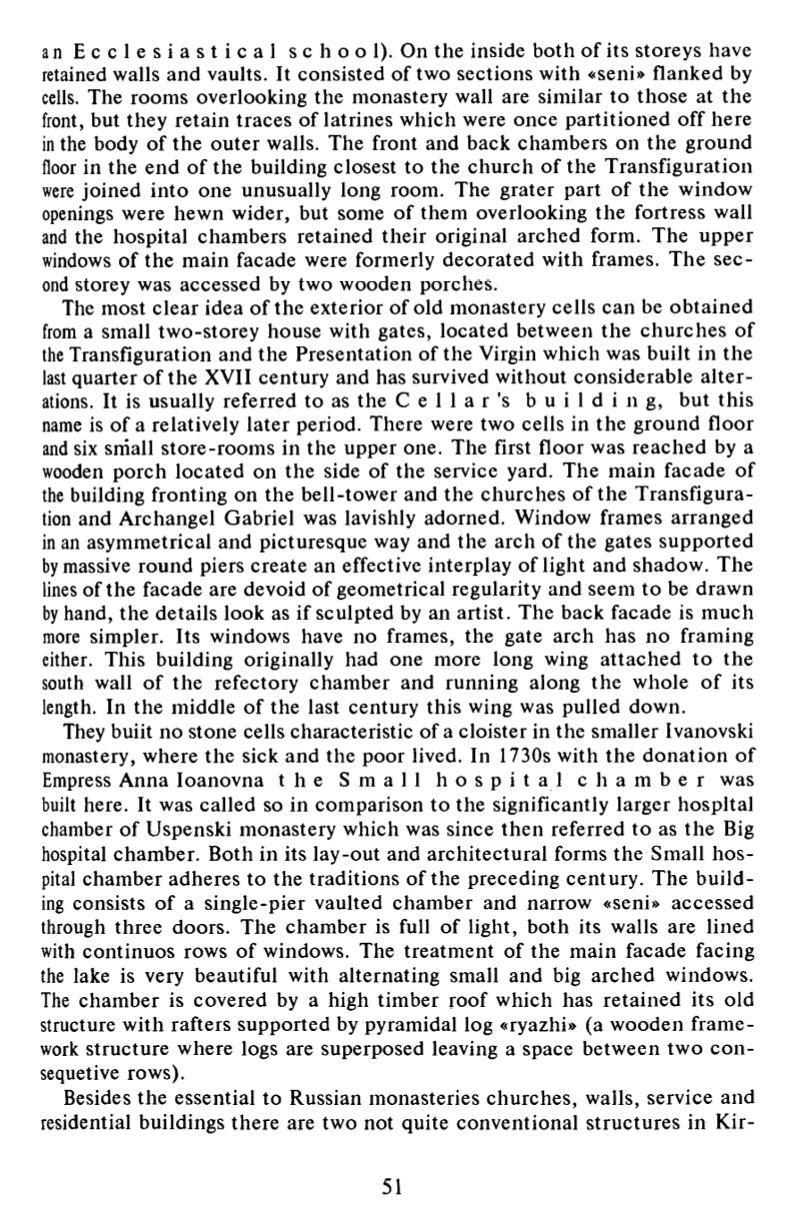

an E c c l e s i a s t i c a l s c h o o l ) . On the inside both o f its storeys have
retained walls and vaults. It consisted of two sections with «seni» flanked by
cells. The rooms overlooking the monastery wall are similar to those at the
front, but they retain traces of latrines which were once partitioned off here
in the body o f the outer walls. The front and back chambers on the ground
floor in the end o f the building closest to the chu rch o f the Transfiguration
were joined into one unusually long room. The grater part o f the window
openings were hewn wider, but some o f them overlooking the fortress wall
and the hospital chambers retained their original arched form. The upper
windows of the main facade were formerly decorated with frames. The s e c
ond storey was accessed by two wooden porches.
The most clear idea o f the exterior of old monastery cells can be ob tained
from a small two-storey house with gates, located between the chu rches of
the Transfiguration and the Presentation of the Virgin which was built in the
last quarter o f the XVII century and has survived without considerable a lte r
ations. It is usually referred to as the С e 1 1 a r ' s b u i l d i n g , but this
name is of a relatively later period. There were two cells in the ground floor
and six small store-rooms in the upper one. The first floor was reached by a
wooden porch located on the side of the service yard. The main facade of
the building fronting on the bell-tower and the churches o f the Transfigura
tion and Archangel Gabriel was lavishly adorned. Window frames arranged
in an asymmetrical and picturesque way and the arch o f the gates supported
by massive round piers create an effective interplay of light and shadow. The
lines of the facade are devoid of geometrical regularity and seem to be drawn
by hand, the details look as if sculpted by an artist. The back facade is much
more simpler. Its windows have no frames, the gate arch has no framing
either. This building originally had one more long wing a ttached to the
south wall o f the refectory chamber and running along the whole o f its
length. In the middle o f the last century this wing was pulled down.
They buiit no stone cells characteristic of a cloister in the smaller Ivanovski
monastery, where the sick and the poor lived. In 1730s with the dona tion o f
Empress Anna Ioanovna t h e S m a l l h o s p i t a l c h a m b e r was
built here. It was called so in comparison to the significantly larger hospital
chamber of Uspenski monastery which was since then referred to as the Big
hospital chamber. Both in its lay-out and architectural forms the Small ho s
pital chamber adheres to the traditions of the preceding century. The bu ild
ing consists o f a single-pier vaulted chamber and narrow «seni» accessed
through three doors. The chamber is full of light, both its walls are lined
with continuos rows o f windows. The treatment of the main facade facing
the lake is very beautiful with alternating small and big arched windows.
The chamber is covered by a high timber roof which has retained its old
structure with rafters supported by pyramidal log «ryazhi» (a wooden frame
work structure where logs are superposed leaving a space between two con -
sequetive rows).
Besides the essential to Russian monasteries churches, walls, service and
residential buildings there are two not quite conventional structures in Kir
51















